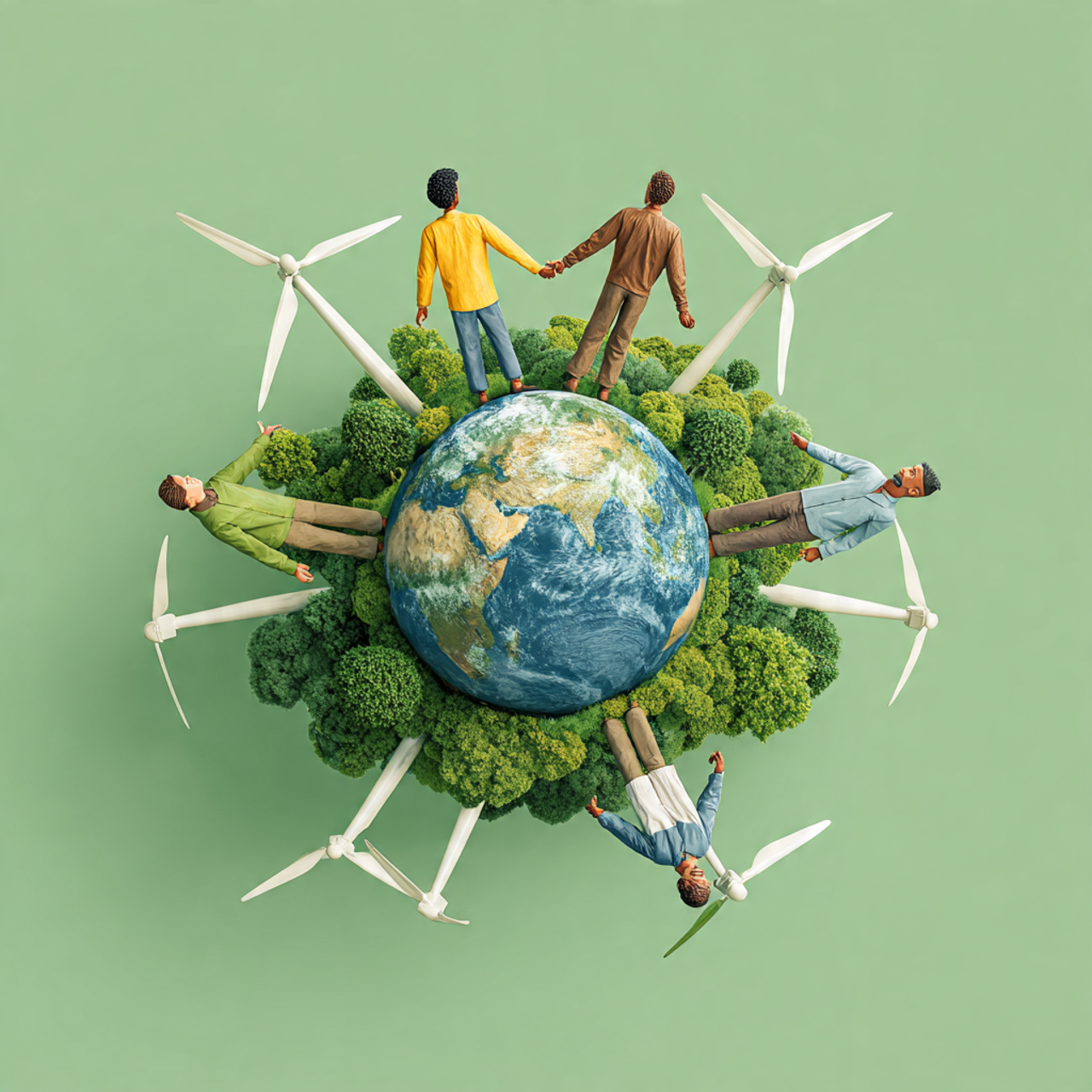
Today, I am presenting to you a unique and comprehensive piece on global cooperation in green technology, being written for the first time in the world. This writing will tell you how global cooperation in green technology is essential for solving climate challenges and building collective resilience. If you like this material, please let us know, and if you need more details on any specific topic, you can contact us.
🌍 Green Technology and Global Cooperation: A New Path for Humanity’s Survival
Global cooperation in green technology has become the most critical need of today’s world, without which it is impossible to cope with the devastating effects of climate change. This cooperation is not limited to environmental agreements alone but is a comprehensive strategy that integrates economic, social, and technical aspects. When we talk about green technology, it includes not only solar or wind energy but also encompasses energy storage systems, sustainable transportation, green buildings, carbon capture technologies, and all aspects of the circular economy. The need for global cooperation also exists because climate change is not confined to the borders of a single country. Carbon emissions from one country affect the climate of the entire world, and similarly, green technology developed in one region can benefit all of humanity. This interdependence is the foundation upon which the edifice of global cooperation in green technology is being built.
Without global cooperation, there are numerous obstacles to the development and implementation of green technology. Developing countries often lack financial resources, technical expertise, and research infrastructure, while developed countries possess the necessary capital and skills for technological development. International cooperation is essential to bridge this gap. The Paris Agreement was a significant step in this regard, where developed countries pledged to transfer green technology and provide financial assistance to developing countries. But the situation has progressed even further now. In the current era, cooperation in green technology is no longer bilateral but has become a multilateral process, involving the private sector, research institutions, civil society, and international organizations.
The economic benefits of global cooperation in green technology are also extremely important. When different countries work together on research and development, not only are time and resources saved, but the resulting technology is also more effective and cheaper. Take the example of solar energy: the primary reason for the 85% drop in solar panel prices over the past decade was international research and economies of scale. The joint efforts of China, Germany, the United States, and other countries have made solar energy cheaper than fossil fuels. Similarly, international cooperation has played a key role in electric vehicle technology. Tesla’s batteries incorporate technology from Japan’s Panasonic, manufacturing expertise from China’s CATL, and lithium supply from Australia. It is this global cooperation that has made electric vehicles viable for common use.
An important aspect of global cooperation is resolving intellectual property issues. Developing countries often complain that patent laws hinder the transfer of green technology. International platforms are being established to solve this problem, where patent pools and technology-sharing agreements can make green technology accessible to more countries. The Climate Technology Centre and Network (CTCN) is an important effort in this regard, providing technical assistance and technology transfer to developing countries.
The greatest benefit of global cooperation in green technology is that it strengthens our collective capacity in the fight against climate change. When all countries work together, not only are the solutions more effective, but the pace of their implementation also accelerates. The COVID-19 pandemic taught us that global challenges can only be faced collectively. Climate change is a similar global challenge that cannot be tackled through individual efforts. Global cooperation in green technology is, in fact, a guarantee for humanity’s collective future.
🌱 Revolution in the Energy Sector: Global Network of Solar and Wind Energy
Global cooperation in green technology within the energy sector has sparked a revolution that has completely transformed the entire energy landscape. Advancements in solar and wind energy have only been possible due to international cooperation. European Union countries have worked together on offshore wind farm projects, while Middle Eastern and North African countries have jointly launched large-scale solar energy projects. The DESERTEC initiative is the best example, aiming to establish vast solar farms in the Sahara Desert to provide clean energy to Europe. Although this project was not entirely successful, it certainly illuminated the possibilities of international cooperation.
Advancements in solar energy technology are the result of international research. Germany’s Fraunhofer Institute for Solar Energy Systems, the US National Renewable Energy Laboratory (NREL), and Japan’s National Institute of Advanced Industrial Science and Technology (AIST) have collectively achieved an extraordinary increase in solar cell efficiency. Joint research by Chinese, Korean, and European scientists in the development of perovskite solar cells has opened new dimensions. It was this international cooperation that enabled an 85% reduction in solar panel prices and made solar energy cheaper than fossil fuels.
Global cooperation has also achieved remarkable developments in the wind energy sector. Denmark’s Vestas, Spain’s Siemens Gamesa, and Germany’s Siemens Energy have collectively brought revolutionary changes to wind turbine technology. Cooperation between the UK, Denmark, Germany, and the Netherlands on offshore wind farm projects has promoted advanced technologies like floating wind turbines. These international partnerships are not only helping in technological development but have also significantly reduced manufacturing costs.
Global cooperation has also played a key role in energy storage systems. Cooperation between Japanese, South Korean, and Chinese companies in the development of lithium-ion batteries has made energy storage solutions affordable and efficient. Tesla’s Gigafactory is a combination of German engineering, Japanese battery technology, and American automation. It is this global cooperation that has reduced battery prices by 90% and enabled the widespread adoption of renewable energy.
International energy grid projects are another important aspect of global cooperation in green energy. The Nord Pool Spot market in the Nordic-Baltic region, the world’s first international electricity market, has promoted the trading of renewable energy. Similarly, the ASEAN Power Grid project is enabling the exchange of clean energy between Southeast Asian countries. These international grid connections not only improve the utilization of renewable energy but also strengthen energy security.
The biggest advantage of global cooperation in the energy sector is that it has made renewable energy economically competitive. International research, shared manufacturing, and global supply chains have dramatically reduced the prices of solar panels, wind turbines, and batteries. Now, renewable energy is not only environmentally friendly but is also economically better than fossil fuels. This change is truly the result of global cooperation.
🏭 Cleanest Industrial Processes: Carbon Capture and Circular Economy
Global cooperation in green technology in the industrial sector has enabled the development of the cleanest industrial processes. International cooperation in Carbon Capture, Utilization, and Storage (CCUS) technologies has achieved revolutionary progress in this field. Norway’s Sleipner and Snøhvit projects, Canada’s Boundary Dam, and the US Petra Nova project have made the practical application of CCUS technology possible. These projects are actually the result of international cooperation, where the technical expertise and financial resources of different countries were combined. The International Energy Agency’s (IEA) CCUS Program has provided an important platform in this regard, where countries exchange their experiences and best practices.
Global cooperation has also played a key role in promoting the concept of the circular economy. The European Union’s Circular Economy Action Plan, Japan’s Sound Material-Cycle Society policy, and China’s Circular Economy Promotion Law have collectively established global standards for the circular economy. International organizations like the Ellen MacArthur Foundation have launched global initiatives to promote circularity in the industrial sector. This cooperation not only helps in environmental protection but also provides economic benefits.
International cooperation has also played a significant role in improving industrial processes. Germany’s Industry 4.0 and Japan’s Society 5.0 concepts have promoted smart manufacturing worldwide. Siemens, GE, and other global companies have developed industrial IoT solutions that reduce energy consumption and increase production efficiency. These technologies are actually the result of international research and cooperation.
The development of green hydrogen in the industrial sector is also becoming possible due to global cooperation. Germany’s Hydrogen Strategy, Japan’s Basic Hydrogen Strategy, and Australia’s National Hydrogen Strategy have collectively laid the foundation for a global green hydrogen market. International partnerships, such as the Germany-Australia Hydrogen Agreement, have helped establish green hydrogen supply chains. This cooperation not only aids in industrial decarbonization but also provides an effective means for storing and transporting renewable energy.
An important aspect of global cooperation in the industrial sector is the establishment of standards and certifications. The International Organization for Standardization’s (ISO) environmental management standards (ISO 14000 series) have set global standards for the environmental performance of industrial organizations. Similarly, LEED certification has established standards for green buildings. These global standards are playing a vital role in promoting sustainability in the industrial sector.
The greatest benefit of global cooperation in the industrial sector is that it has reduced the costs of clean industrial technologies. International research and shared manufacturing have made CCUS, green hydrogen, and other clean industrial technologies more affordable. This reduction is accelerating the decarbonization of the industrial sector and making the achievement of net-zero targets possible.
🏙️ Sustainable Urban Development: Green Buildings and Smart Cities
Global cooperation in green technology in urban areas has established new standards for sustainable urban development. International cooperation in the design and construction of green buildings has enabled the development of energy-efficient buildings. Buildings like Singapore’s Parkroyal on Pickering, Germany’s Vauban district, and Denmark’s 8 House are actually the result of international cooperation, where architects and engineers from different countries have worked together. Under the World Green Building Council, green building councils from more than 70 countries are collectively setting global standards for green buildings.
Global cooperation has also played a significant role in smart city projects. Singapore’s Smart Nation initiative, South Korea’s Songdo International Business District, and Spain’s Barcelona Smart City project have set global benchmarks for smart cities. The International Standards Organization’s (ISO) smart city standards (ISO 37120) have established global standards for city performance measurement. This cooperation not only helps improve the quality of urban life but is also leading to reduced energy use and lower carbon emissions.
Global cooperation has also achieved notable developments in sustainable transportation systems. Cooperation between America’s Tesla, Japan’s Nissan, and Germany’s Volkswagen in the development of electric vehicles has promoted EV technology. International partnerships, such as the Charging Interface Initiative (CharIN), have established global standards for EV charging. Similarly, international cooperation has also advanced public transportation systems. Cooperation between France’s Alstom, Germany’s Siemens, and Canada’s Bombardier has enabled the development of high-speed rail and other sustainable transport solutions.
Global cooperation has also played a key role in promoting the concept of green infrastructure in urban planning. Singapore’s “Garden City” vision, America’s New York City High Line park, and the Netherlands’ Rotterdam water squares have presented global models of green infrastructure in urban areas. Under the C40 Cities Climate Leadership Group, more than 100 major cities worldwide are working together on climate action. This cooperation is helping to strengthen the resilience of urban areas.
Global cooperation has also advanced waste management systems in urban areas. Sweden’s waste-to-energy plants, Japan’s efficient recycling systems, and Germany’s circular economy models have established global best practices for urban waste management. Under the International Solid Waste Association (ISWA), countries exchange their waste management experiences. This cooperation is helping to increase waste reduction and recycling rates in urban areas.
The biggest advantage of global cooperation in urban areas is that it has reduced the costs of sustainable urban solutions. International research and shared experiences have made green buildings, smart city technologies, and sustainable transport systems more affordable. This reduction is accelerating the sustainable transformation of urban areas and making the establishment of climate-resilient cities possible.
💧 Revolution in Water and Agriculture: Sustainable Food Security
Global cooperation in green technology in the water and agriculture sectors has illuminated new possibilities for sustainable food security. International cooperation in water conservation and management has enabled the development of water-efficient technologies. Israel’s drip irrigation systems, Singapore’s NEWater technology, and the Netherlands’ water management solutions have set new standards for water conservation worldwide. International organizations like the World Water Council and the International Water Association have promoted global cooperation in water management.
Global cooperation has also played a key role in promoting sustainable practices in agriculture. Cooperation between America’s John Deere, Germany’s Bosch, and Japan’s Kubota in the development of precision agriculture has promoted smart farming solutions. International initiatives, such as the Food and Agriculture Organization’s (FAO) Climate-Smart Agriculture program, have established global standards for sustainable agriculture. This cooperation is not only increasing food production but is also reducing the environmental impact of agriculture.
Global cooperation has also advanced modern agricultural techniques like vertical farming and hydroponics. Cooperation between Netherlands’ vertical farming research, Japan’s plant factory technologies, and American companies like AeroFarms has opened new avenues for urban agriculture. Under the International Society for Horticultural Science (ISHS), researchers and practitioners are working together on modern agricultural techniques.
Global cooperation has also played a significant role in securing food supply chains. Projects using blockchain technology to improve food traceability involve global companies like IBM Food Trust, Walmart, and Nestlé working together. This cooperation is not only reducing food waste but is also strengthening food security.
The greatest benefit of global cooperation in the water and agriculture sectors is that it has enabled the development of climate-resilient food systems. International research and technology transfer have promoted water-efficient irrigation, drought-resistant crops, and sustainable farming practices. These advancements are helping to ensure food security despite climate change.
🌳 Environmental Protection and Biodiversity: Global Efforts to Protect the Earth
Global cooperation in green technology for environmental protection and biodiversity conservation has given a new dimension to Earth’s conservation efforts. Under the United Nations Environment Programme (UNEP), countries are working together on global environmental goals. The Convention on Biological Diversity (CBD) has provided an international framework for biodiversity conservation. This cooperation not only helps protect ecosystems but also plays a key role in climate change mitigation.
Global cooperation has also played a significant role in forest conservation and reforestation projects. Under the UN-REDD Programme, financial assistance is being provided to developing countries for forest conservation. The World Resources Institute’s Global Forest Watch initiative has provided a global platform for forest monitoring. This cooperation is helping to reduce deforestation rates and increase carbon sequestration.
Global cooperation has also advanced marine conservation. The United Nations Ocean Conference has set global goals for ocean conservation. The International Union for Conservation of Nature’s (IUCN) Marine Protected Areas program has established a global network for the protection of marine ecosystems. This cooperation helps protect marine biodiversity and reduce the impacts of ocean acidification.
Global cooperation has also played a key role in wildlife conservation. The Convention on International Trade in Endangered Species (CITES) has provided an international framework for the protection of endangered species. The World Wildlife Fund’s (WWF) global conservation programs have helped protect wildlife habitats. This cooperation aids in biodiversity conservation and maintaining ecological balance.
The greatest benefit of global cooperation in environmental protection is that it has increased the effectiveness of conservation efforts. International cooperation and resource sharing have enabled the exchange of conservation technologies and best practices. This cooperation is helping to ensure the long-term sustainability of Earth’s ecosystems.
💰 Financial System and Investment: Foundations of the Green Economy
Global cooperation in the financial aspects of green technology has strengthened the foundations of the green economy. International cooperation in climate finance mechanisms has provided financial resources to developing countries for investment in green technology. International organizations like the Green Climate Fund, the Global Environment Facility, and the Climate Investment Funds have provided financial support for climate projects. This cooperation not only enables the implementation of green technology but also helps balance economic development and environmental protection.
Global cooperation has also advanced in the field of sustainable investing. The recommendations of the Task Force on Climate-related Financial Disclosures (TCFD) have established global standards for climate risk reporting in the corporate sector. The Network for Greening the Financial System (NGFS) has enabled the exchange of best practices in climate risk management among central banks and financial regulators. This cooperation helps strengthen the resilience of the financial system.
Global cooperation has also developed the markets for green bonds and sustainable securities. The International Capital Market Association’s (ICMA) Green Bond Principles have established global standards for green bond issuance. The Climate Bonds Initiative’s certification scheme has strengthened the credibility of green investments. This cooperation is promoting capital mobilization for green projects.
Global cooperation has also played a key role in the development of carbon markets. Article 6 of the Paris Agreement provided a framework for international carbon markets. The International Carbon Action Partnership (ICAP) has enabled the exchange of best practices in the design and implementation of carbon pricing systems. This cooperation is providing cost-effective mechanisms for reducing carbon emissions.
The greatest benefit of global cooperation in the financial aspects of the green economy is that it has reduced the risks of green investments. International cooperation and risk-sharing mechanisms have promoted private sector investment in green technology. This cooperation is accelerating the transition to a green economy.
🌐 Future Pathways: A Collective Vision for Green Technology
The future pathways of global cooperation in green technology reflect humanity’s collective vision. International cooperation in emerging technologies has enabled the development of future green technologies. Projects using artificial intelligence and machine learning to improve the prediction and adaptation to the effects of climate change involve Google DeepMind, Microsoft AI for Earth, and other global initiatives working together. This cooperation is increasing the accuracy of climate modeling and impact assessment.
Global cooperation has also advanced in the potential applications of quantum computing. IBM Q Network, Google Quantum AI, and other research institutions have collectively developed quantum algorithms that will help in the discovery of new materials and the development of energy storage solutions. This cooperation is laying the foundation for future green technologies.
Global cooperation has also advanced in using space-based technologies to monitor Earth’s ecosystems. The European Space Agency’s (ESA) Copernicus Program, NASA’s Earth Science Division, and JAXA’s Earth Observation Research Center have collectively provided earth observation data. This cooperation aids in climate change monitoring and natural disaster management.
Global cooperation has also advanced in next-generation nuclear technologies. Thirty-five countries are working together on the International Thermonuclear Experimental Reactor (ITER) project to develop fusion energy. The Generation IV International Forum (GIF) has provided a cooperation framework for the development of next-generation nuclear reactors. This cooperation is helping to develop new sources of clean energy.
The greatest future benefit of global cooperation in green technology will be that it provides collective solutions to humanity’s collective challenges. International cooperation, shared research, and joint innovation have accelerated the development and implementation of green technology. This cooperation is, in fact, a guarantee for humanity’s sustainable future.


